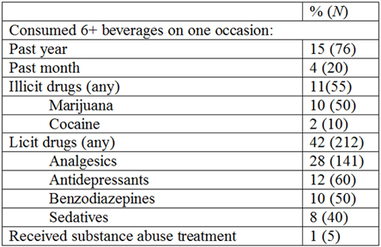Many societies regard higher education as a protectorate against addiction. Such culturally developed beliefs can create biases that preclude opportunities for early detection of problems and consequently early intervention. In this issue of Addiction and the Humanities, we review evidence of substance-related problems among the highly educated. Although education tends to decrease the likelihood of substance-related addiction (Substance Abuse and Mental Health Services Administration, 2005), the highly educated are not immune to developing substance use problems.
Researchers surveyed a highly educated workforce (Matano, Wanat, Westrup, Koopman, & Whistsell, 2002) to investigate the prevalence of risky substance use behaviors among a more educated workforce. Matano et al. (2002) randomly selected 10% (N=857) of employees to receive surveys regarding their substance use behaviors during the previous 12 months. Of these eligible employees, 504 sent back completed surveys. Respondents were 62.8% female and ranged in age from 21 to 78 (M=43.8). Eighty one percent of the sample earned a bachelor’s degree or higher and 3% earned a high school diploma or less.
Table 1 summarizes the survey results. The results reveal that alcohol and licit drug use was more prevalent than illicit substance use among this sample. A significant number of employees however, reported illicit drug use during the past year. Based on responses to the CAGE (Ewing, 1984), 12% qualified for “likely to have lifetime alcohol dependence.” Responses to the AUDIT (Bush, Kivlahan, Mcdonnell, Fihn, & Bradley, 1998) indicated that 5% had a “high likelihood of alcohol abuse.” In addition, 3% claimed that their alcohol consumption caused injury to someone else. Despite these results only a handful of employees reported receiving any substance abuse treatment over the last year.
Table 1. Past year substance use among employees (N=504)
There are several limitations to this study. For example, the 60% response rate might result in substance use differences between those that completed and those that did not complete the survey. In addition, this survey was conducted in 1999, and it is possible that substance use behaviors among highly educated employees have changed since then. Finally, substance use might be a more sensitive topic for the highly educated, perhaps biasing the self-report in the direction of underreporting.
Despite constraints that might limit the extent of reported substance use and related problems, this study confirms that substance use and abuse is not an issue reserved only for less educated individuals. There is a need for employee prevention and intervention programs in work forces populated by the highly educated. Assuming that educated individuals are immune to substance use problems might diminish their chances of getting the help they need.
References
Bush, K., Kivlahan, D. R., Mcdonnell, M. B., Fihn, S. D., & Bradley, K. A. (1998). The AUDIT alcohol consumption questions (AUDIT-C): an effective brief screening test for problem drinking. Archives of Internal Medicine, 158, 1789-1795.
Ewing, J. A. (1984). Detecting alcoholism: the CAGE questionnaire. Journal of the American Medical Association, 252(14), 1905-1907.
Matano, R. A., Wanat, S. F., Westrup, D., Koopman, C., & Whistsell, S. D. (2002). Prevalence of Alcohol and Drug Use in a Highly Educated Workforce. The Journal of Behavioral Health Services & Research, 29(1), 30-44.
Substance Abuse and Mental Health Services Administration. (2005). Overview of findings from the 2004 National Household Survey on Drug Abuse: Volume 1. Summary of National Findings (No. SMA 05-4061). Rockville, MD.





